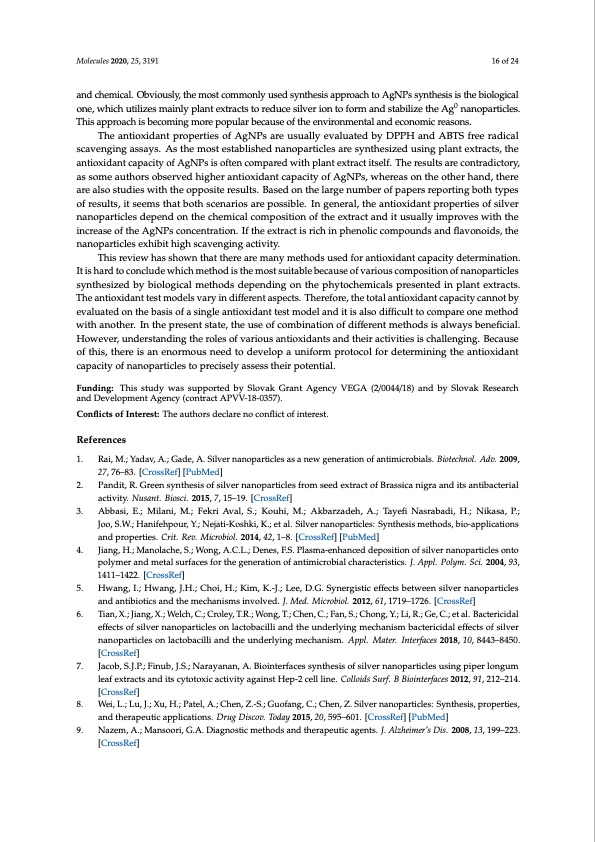
PDF Publication Title:
Text from PDF Page: 016
Molecules 2020, 25, 3191 16 of 24 and chemical. Obviously, the most commonly used synthesis approach to AgNPs synthesis is the biological one, which utilizes mainly plant extracts to reduce silver ion to form and stabilize the Ag0 nanoparticles. This approach is becoming more popular because of the environmental and economic reasons. The antioxidant properties of AgNPs are usually evaluated by DPPH and ABTS free radical scavenging assays. As the most established nanoparticles are synthesized using plant extracts, the antioxidant capacity of AgNPs is often compared with plant extract itself. The results are contradictory, as some authors observed higher antioxidant capacity of AgNPs, whereas on the other hand, there are also studies with the opposite results. Based on the large number of papers reporting both types of results, it seems that both scenarios are possible. In general, the antioxidant properties of silver nanoparticles depend on the chemical composition of the extract and it usually improves with the increase of the AgNPs concentration. If the extract is rich in phenolic compounds and flavonoids, the nanoparticles exhibit high scavenging activity. This review has shown that there are many methods used for antioxidant capacity determination. It is hard to conclude which method is the most suitable because of various composition of nanoparticles synthesized by biological methods depending on the phytochemicals presented in plant extracts. The antioxidant test models vary in different aspects. Therefore, the total antioxidant capacity cannot by evaluated on the basis of a single antioxidant test model and it is also difficult to compare one method with another. In the present state, the use of combination of different methods is always beneficial. However, understanding the roles of various antioxidants and their activities is challenging. Because of this, there is an enormous need to develop a uniform protocol for determining the antioxidant capacity of nanoparticles to precisely assess their potential. Funding: This study was supported by Slovak Grant Agency VEGA (2/0044/18) and by Slovak Research and Development Agency (contract APVV-18-0357). Conflicts of Interest: The authors declare no conflict of interest. References 1. Rai, M.; Yadav, A.; Gade, A. Silver nanoparticles as a new generation of antimicrobials. Biotechnol. Adv. 2009, 27, 76–83. [CrossRef] [PubMed] 2. Pandit, R. Green synthesis of silver nanoparticles from seed extract of Brassica nigra and its antibacterial activity. Nusant. Biosci. 2015, 7, 15–19. [CrossRef] 3. Abbasi, E.; Milani, M.; Fekri Aval, S.; Kouhi, M.; Akbarzadeh, A.; Tayefi Nasrabadi, H.; Nikasa, P.; Joo, S.W.; Hanifehpour, Y.; Nejati-Koshki, K.; et al. Silver nanoparticles: Synthesis methods, bio-applications and properties. Crit. Rev. Microbiol. 2014, 42, 1–8. [CrossRef] [PubMed] 4. Jiang, H.; Manolache, S.; Wong, A.C.L.; Denes, F.S. Plasma-enhanced deposition of silver nanoparticles onto polymer and metal surfaces for the generation of antimicrobial characteristics. J. Appl. Polym. Sci. 2004, 93, 1411–1422. [CrossRef] 5. Hwang, I.; Hwang, J.H.; Choi, H.; Kim, K.-J.; Lee, D.G. Synergistic effects between silver nanoparticles and antibiotics and the mechanisms involved. J. Med. Microbiol. 2012, 61, 1719–1726. [CrossRef] 6. Tian, X.; Jiang, X.; Welch, C.; Croley, T.R.; Wong, T.; Chen, C.; Fan, S.; Chong, Y.; Li, R.; Ge, C.; et al. Bactericidal effects of silver nanoparticles on lactobacilli and the underlying mechanism bactericidal effects of silver nanoparticles on lactobacilli and the underlying mechanism. Appl. Mater. Interfaces 2018, 10, 8443–8450. [CrossRef] 7. Jacob, S.J.P.; Finub, J.S.; Narayanan, A. Biointerfaces synthesis of silver nanoparticles using piper longum leaf extracts and its cytotoxic activity against Hep-2 cell line. Colloids Surf. B Biointerfaces 2012, 91, 212–214. [CrossRef] 8. Wei, L.; Lu, J.; Xu, H.; Patel, A.; Chen, Z.-S.; Guofang, C.; Chen, Z. Silver nanoparticles: Synthesis, properties, and therapeutic applications. Drug Discov. Today 2015, 20, 595–601. [CrossRef] [PubMed] 9. Nazem, A.; Mansoori, G.A. Diagnostic methods and therapeutic agents. J. Alzheimer’s Dis. 2008, 13, 199–223. [CrossRef]PDF Image | Antioxidant Activity Determination of Silver Nanoparticles

PDF Search Title:
Antioxidant Activity Determination of Silver NanoparticlesOriginal File Name Searched:
molecules-25-03191.pdfDIY PDF Search: Google It | Yahoo | Bing
Turbine and System Plans CAD CAM: Special for this month, any plans are $10,000 for complete Cad/Cam blueprints. License is for one build. Try before you buy a production license. More Info
Waste Heat Power Technology: Organic Rankine Cycle uses waste heat to make electricity, shaft horsepower and cooling. More Info
All Turbine and System Products: Infinity Turbine ORD systems, turbine generator sets, build plans and more to use your waste heat from 30C to 100C. More Info
CO2 Phase Change Demonstrator: CO2 goes supercritical at 30 C. This is a experimental platform which you can use to demonstrate phase change with low heat. Includes integration area for small CO2 turbine, static generator, and more. This can also be used for a GTL Gas to Liquids experimental platform. More Info
Introducing the Infinity Turbine Products Infinity Turbine develops and builds systems for making power from waste heat. It also is working on innovative strategies for storing, making, and deploying energy. More Info
Need Strategy? Use our Consulting and analyst services Infinity Turbine LLC is pleased to announce its consulting and analyst services. We have worked in the renewable energy industry as a researcher, developing sales and markets, along with may inventions and innovations. More Info
Made in USA with Global Energy Millennial Web Engine These pages were made with the Global Energy Web PDF Engine using Filemaker (Claris) software.
Infinity Turbine Developing Spinning Disc Reactor SDR or Spinning Disc Reactors reduce processing time for liquid production of Silver Nanoparticles.
| CONTACT TEL: 608-238-6001 Email: greg@infinityturbine.com | RSS | AMP |